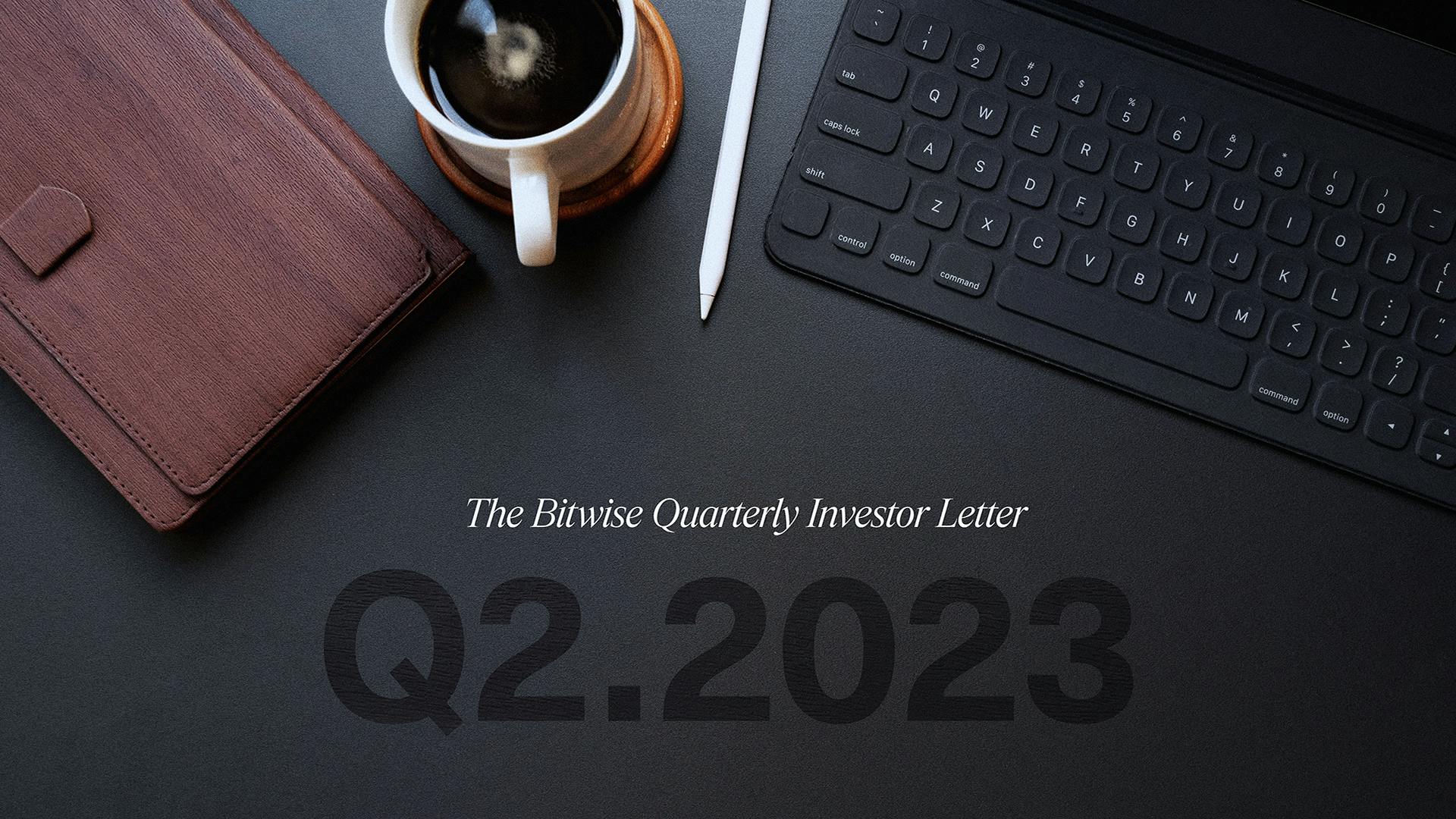Timely Insights
Seven Debates Driving Value in the Crypto Market
San Francisco • August 9, 2018

Why do you need ten cryptoassets? Because there are huge debates right now about how to build the best blockchain.
We at Bitwise have been asked numerous times for our view on the volatility and viability of different large-cap cryptoassets, particularly in light of bitcoin’s declining market dominance.
Our view is that the rapid diversification of value in the cryptoasset space reflects two things: first, that there are a number of large, critical and divisive structural experiments taking place in crypto today; and second, that there is a rapid and continuous iteration in new applications within the space.
This document focuses primarily on the structural debates, which are particularly important for large-cap assets. Our view is that the ultimate outcome of these debates is at this point deeply uncertain and in fact unknowable. Those outcomes will be driven by technological developments and network effects, but also by significant exogenous factors like regulatory developments and other unforeseen events.
In this document, we’ve tried to lay out both sides of the most important debates driving value in the cryptomarket.
Debate #1 – Decentralization vs. Speed
The technical architecture of blockchains like the bitcoin blockchain emphasize decentralization and censorship resistance over speed when processing transactions. Bitcoin is extremely decentralized but can only handle approximately 4 transactions per second (txn/second). Blockchains like EOS, by contrast, trade higher degrees of centralization for much higher speeds; EOS can handle over 2,000 txn/second. As context, Visa’s network currently processes approximately 2,000 txn/second as well.
Some people think speed is not a key factor for public blockchains. That’s particularly true for individuals who focus on the use of cryptoassets as a long-term store of value (like a “digital gold”). If you’re using bitcoin to buy a cup of coffee, the speed at which transactions are processed on the network is critical; if you’re holding bitcoin for 20 years or using it only for large-scale purchases like buying a house, the speed of that transaction is less important.
Not everyone agrees, of course, and for those who care about speed, there is a huge debate on the best way to speed up a blockchain. Some think there are ways to enhance the blockchain’s code to incrementally boost its speed while maintaining strong decentralization. One common proposal is to increase the size of blocks – literally allow more information to be stored in each block of transactions. These and other proposals are called “on-chain” enhancements, because they happen at the point of the blockchain itself.
Others think decentralized blockchains can only or primarily scale through complementary “off-chain” systems, like the proposed Lightning network for bitcoin. These solutions integrate with the existing blockchain and extend its performance, but don’t require altering the blockchain’s code.
Finally, large parts of the community think blockchains must be designed for speed from the start, and that it’s worth sacrificing some amount of centralization to achieve this speed.
We do not know how this will turn out. All approaches are being attempted, and the space is evolving rapidly over time. The debate is critical, however, and at this point, spreading bets across different blockchains targeting different points on this spectrum seems prudent.
Debate #2 – General vs. Limited Computation
Bitcoin’s scripting language is very limited in its capabilities: It can be used to send bitcoin somewhere, receive it, look at it, etc., but that’s about it. To use a programmer’s phrase, it is not Turing-complete.
The decision to limit bitcoin’s programming language was intentional. With a focus on monetary use cases, bitcoin’s creator wanted to limit the potential for programming bugs. This is a common decision when approaching software security design, and is known as “limiting the attack surface.” The downside of limiting the attack surface is that it also limits the range of what a given software is capable of supporting.
By contrast, other blockchains like ethereum were purposefully designed to be Turing-complete. It’s this Turing-completeness that allows ethereum (and similar blockchains) to handle a wide range of instructions, including conditional if/then statements, called smart contracts, and to serve as a platform for multiple decentralized applications (dApps).
The downside is that there is more potential for bugs and security holes. For instance, Parity, one of the most popular Ethereum wallets, has been unable to build an effective multisignature security feature despite multiple attempts.
The debate around functionality vs. security is likely to continue. Our expectation is that there is room for both approaches to thrive, as they offer different capabilities and trade-offs.
Debate #3 – Privacy
Different cryptoassets provide different levels of privacy for users. Bitcoin and many other blockchains’ transactions are pseudonymous; transactions cannot be traced back to specific individuals, but can be easily traced to individual wallets. This is similar to how phone calls are tied to your phone number, but not necessarily to your identity, unless you choose to reveal it.
Other cryptoassets, including Zcash, Monero and DASH, have either the option of or a default state of anonymity: Transactions can be or are always intentionally obscured, intermingled, or otherwise rendered completely untraceable.
As with the speed vs. centralization debate, there are multiple points of view on what the best state for a public blockchain is regarding privacy. Many support privacy as a core right, with implementation the only concern. Others worry that regulators will take action against privacy coins (which, for example, make anti-money-laundering reviews difficult or impossible for financial institutions to conduct), and that privacy features are a risk to long-term adoption.
We’re unsure how this will play out as well, although we think it’s likely that having the option of sending a private transaction will become the norm. It is nonetheless easy for us to imagine a world where one or more privacy coins becomes hugely important by offering a best-in-class privacy solution; a world where large established chains add privacy capabilities (ethereum, for example, is expected to add privacy options in the future); and a world where regulators take aggressive action against privacy coins in one or more jurisdictions.
From our perspective, again, spreading bets across multiple coins along different stages of the privacy spectrum is the optimal strategy.
Debate #4 – Consensus Mechanism
Every blockchain has a consensus protocol– a set of specifically defined rules for how disparate actors will agree on things. It is one of the core innovations that enable public blockchains.
There is, however, a large debate in the crypto community around the best way for the network to arrive at consensus. Bitcoin’s use of a proof-of-work methodology– whereby miners spend extensive computing and electrical power to solve complex mathematical problems– has proven effective and secure, but attracts criticism for its high energy use and high cost. Alternate approaches, of which proof-of-stake is one of the best known, avoid this, but have a less established track record.
Other debates surrounding consensus protocols center on how and whether to guard against the over-concentration of mining power in large corporations or large conglomerates, which may unintentionally centralize a decentralized system.
Different blockchains have different approaches to this problem, and it’s unclear which is the best approach. Because the security and robustness of the consensus mechanism is foundational to a blockchain’s existence– and because the financial costs involved in mining are large– this is a lively and critical debate in the community.
Debate #5 – Pre-mining and Foundations/Supporting Entities
There is a significant debate in the crypto ecosystem on the value of having a centralized entity that is able to support, foster, and influence the direction of a blockchain project. Many projects, such as Ripple and Stellar, featured large “pre-mine” hoarding of cryptoassets for the organization that coordinated their development. EOS was famously launched through an ICO process that raised $4 billion for a related company (Block.One). Meanwhile, Zcash has a feature that contributes 10% of every block reward to a central foundation.
On the one hand, large foundations or supporting companies have a war chest they can deploy to foster development of the network and/or the community surrounding a blockchain. They often do this by paying developers to work on the core underlying software, hosting hackathons to develop related dApps, coordinating lobbying efforts to support the coin, doing marketing, etc.
On the flip side, many worry that having powerful entities close to projects harms the benefits that accrue to public blockchains from being decentralized. Ripple, in particular, receives a good amount of skepticism for being a potentially controlling entity in the development of XRP. Additionally, there is concern about how and when foundations or supporting entities will sell coins to fund operations, and this overhang can impact valuations as well.
There is as yet no generalized agreement on the best approach.
Debate #6 – Code Is Law vs. Community Is Law (Governance)
There is a major debate on the appropriate way to govern public blockchains. Many believe the core point of public blockchains is that the code embedded in the blockchain is law, and anything allowed by the code is therefore allowed by the chain. Others believe the community surrounding a particular chain can interpret that law as it sees fit.
This debate famously erupted in the ethereum community following the DAO hack, where a hacker exploited a bug in the code for a smart contract hosted on the ethereum blockchain and stole $70 million. This eventually led to a hard fork in ethereum, wherein most of the community agreed to undo the transaction by creating a new version of the ledger restoring the stolen asset to the original owners. This blockchain retained the name “ethereum.” Not everyone supported this switch, however, and the old, unchanged network that supports the “code is law” point of view continued under the new name “Ethereum Classic.” Ethereum Classic did not restore the hacked assets. Today both cryptoassets have significant value.
This debate is evolving on an almost daily basis. Many new chains (such as EOS and Tezos) have created mechanisms to resolve disputes on-chain, and those efforts have seen successes as well as failures. Handling governance is a key and contentious issue playing out in the battle for blockchain dominance right now.
Debate #7 – Specific and Future Use Cases
Finally, the increasing diversification of value among leading cryptoassets reflects the evolving use-case targets of public blockchain technology. While all the coins currently in the Bitwise 10 Large Cap Crypto Index are either generalist coins with broad applications or monetary assets, coins further down the spectrum have specific use cases, such as file storage (Filecoin), prediction markets (Augur) and trading (0x). And every day, developers are experimenting with creating public blockchains for new and specific areas that merit different trade-offs and specialization. We expect this trend to continue and expand as developers explore all the ways the tech can be put to use.
Conclusion
It’s important to remember that we’re still in the early stages of blockchain development. If you look back at other popular protocols that have emerged, it’s common for there to be a period of experimentation where different protocols compete for user attention. Sometimes multiple protocols survive this period of experimentation: iOS and Android are one example of that. Sometimes, competing protocols die off and the world anchors on a single choice: VHS over Betamax, HD DVD over BluRay, or perhaps most tellingly, TCP/IP over OSI in the early days of the internet are examples of this.
Our view is that the future is unknowable. One of the things that makes a monthly rebalanced, uncapped, market-cap-weighted index so attractive is that it guarantees that, whatever happens to the experiments listed above, if the category is massively successful, the index will also do well.
About Bitwise
Bitwise Asset Management is the largest crypto index fund manager in America. Thousands of financial advisors, family offices, and institutional investors partner with Bitwise to understand and access the opportunities in crypto. For six years, Bitwise has established a track record of excellence managing a broad suite of index and active solutions across ETFs, separately managed accounts, private funds, and hedge fund strategies. Bitwise is known for providing unparalleled client support through expert research and commentary, its nationwide client team of crypto specialists, and its deep access to the crypto ecosystem. The Bitwise team of more than 60 professionals combines expertise in technology and asset management with backgrounds including BlackRock, Millennium, ETF.com, Meta, Google, and the U.S. Attorney’s Office. Bitwise is backed by leading institutional investors and has been profiled in Institutional Investor, Barron’s, Bloomberg, and The Wall Street Journal. It has offices in San Francisco and New York. For more information, visit www.bitwiseinvestments.com.



